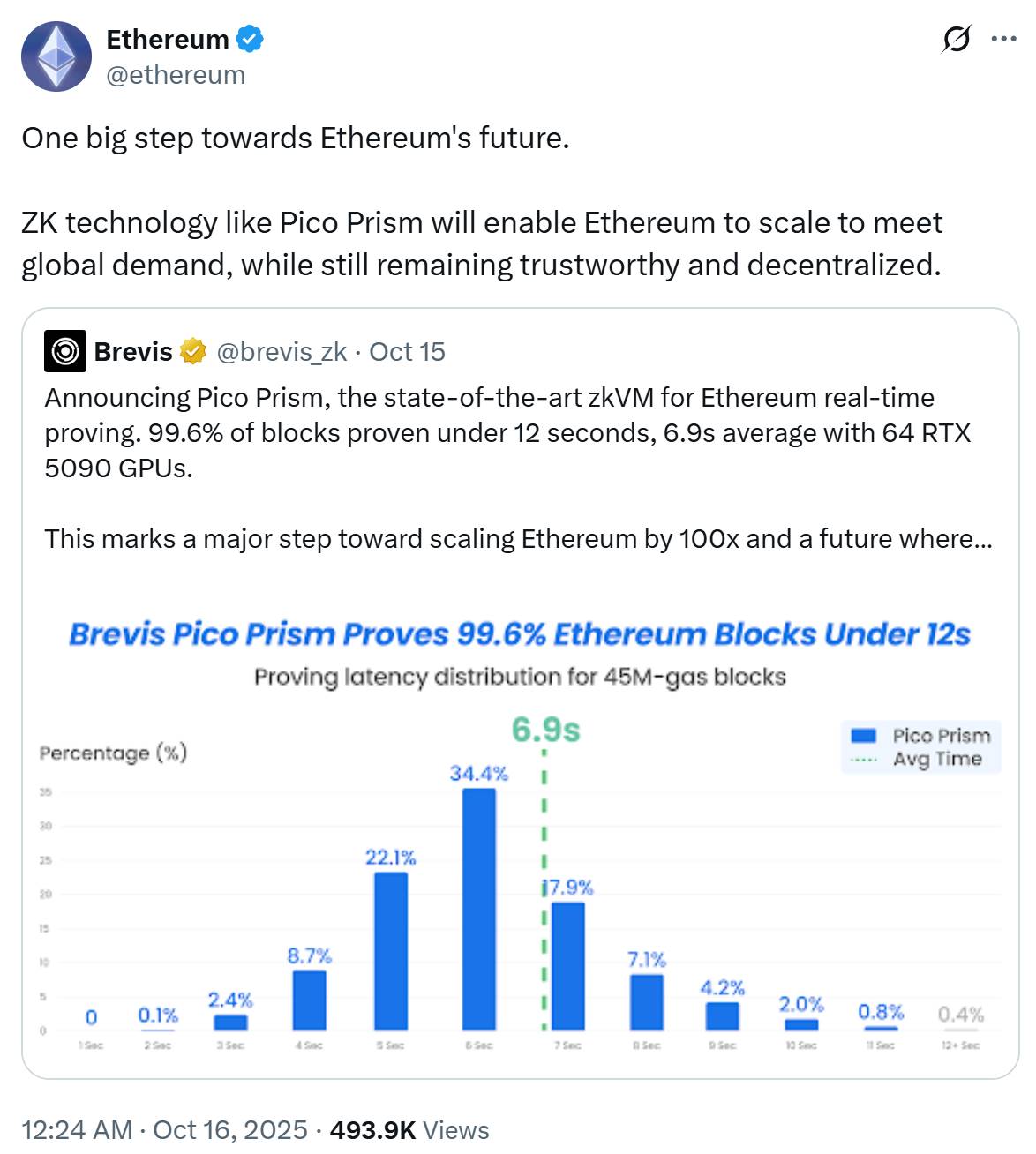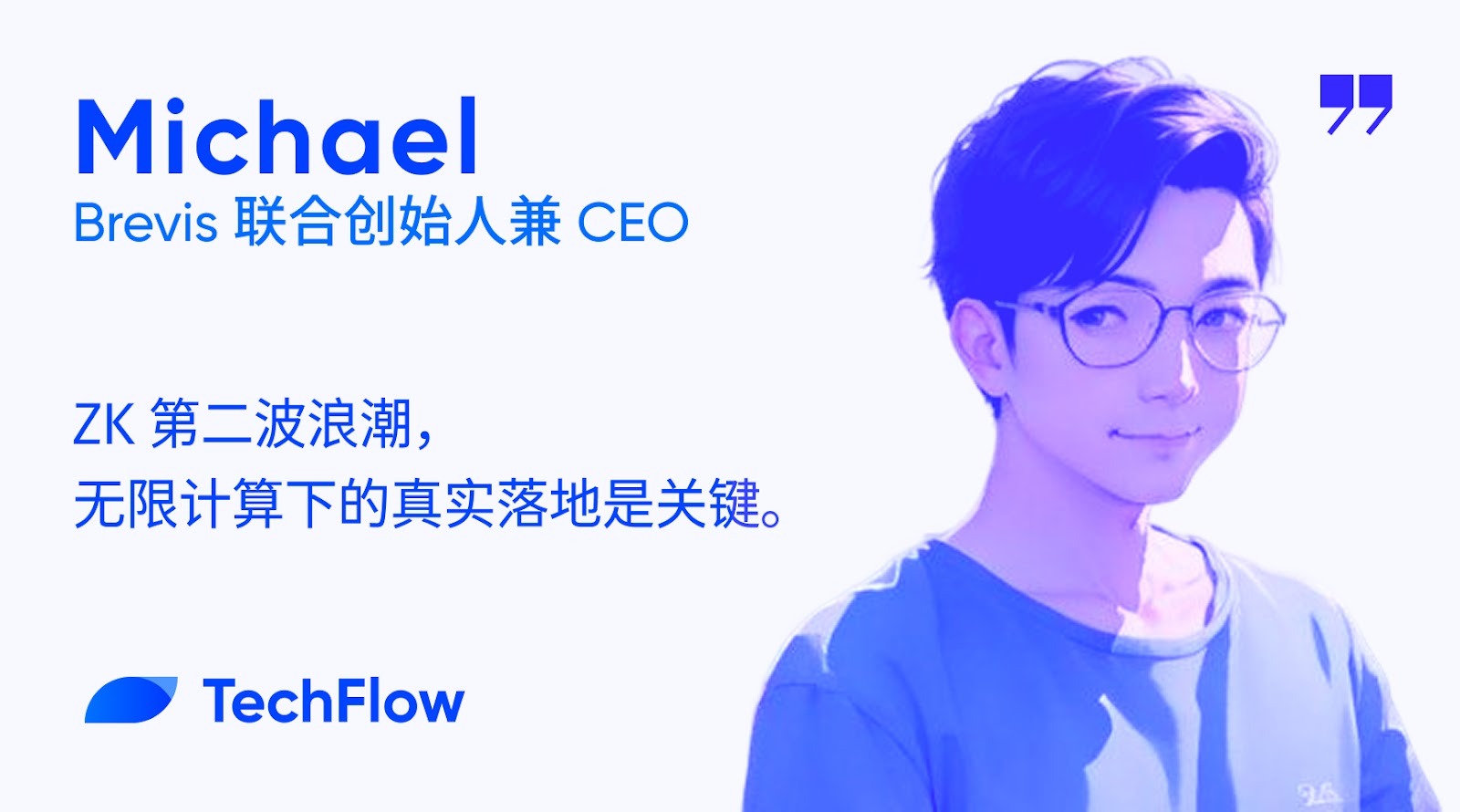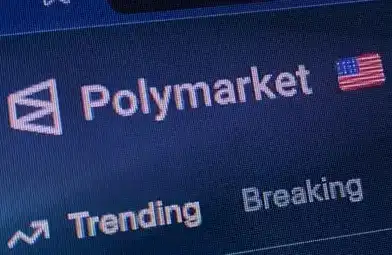Dialogue with Brevis Co-founder: The Second Wave of ZK, Real-world Implementation under Unlimited Computation is the Key
From real-time Ethereum proving to full application coverage across Web3 and Web2.
What is happening in the Ethereum ecosystem that has attracted collective retweets, support, and discussion from Vitalik Buterin, the official Ethereum Twitter, and Ethereum OG researcher Justin Drake?
On October 15, 2025, ZK all-chain data computation and verification platform Brevis announced that its zkVM Pico Prism has achieved real-time Ethereum proving on consumer-grade hardware: Using 64 RTX 5090 graphics cards, it completed 99.6% of Ethereum L1 block proofs within 12 seconds, with 96.8% of block proofs meeting the Ethereum Foundation's standard of under 10 seconds. In a test on September 1, 2025, under Ethereum's current 45M gas limit, Pico Prism achieved an average proof time of just 6.9 seconds.
Regarding this release, the official Ethereum Twitter retweeted and commented: This is a big step toward the future of Ethereum.

From the official Ethereum Twitter to its founder and OGs, the community's excitement is palpable, sparking curiosity: What exactly is the major breakthrough of Pico Prism? How did Brevis achieve this important milestone?
On the eve of Pico Prism's announcement of real-time Ethereum proving, Deep Tide TechFlow had an in-depth conversation with Brevis co-founder and CEO Michael.
Speaking about the much-discussed Pico Prism, Michael proudly stated:
This breakthrough not only means we are now the fastest zkVM in the world, but it is also a major step forward for the Ethereum community, greatly expanding Ethereum's capacity and even achieving truly unlimited scalability. At the same time, real-time Ethereum proving significantly improves blockchain processing efficiency and confirmation speed. It can be said that this is a landmark move for major Ethereum network upgrades in the coming year, and the future Ethereum may fully shift to a zkVM-centric architecture.
When discussing Brevis's differentiated advantages compared to other ZK projects, Michael immediately gave three key points:
First, we focus heavily on real-world adoption and have already achieved widespread use across multiple scenarios; second, we have strong future scalability, able to adapt to ever-changing and diverse needs. Finally, we offer ease of use and universality—developers don't need to deeply understand the complex principles of ZK, they just need to easily generate proofs and enjoy powerful off-chain computation capabilities.
Finally, as a project whose development results are highly aligned with the Ethereum roadmap, Michael also shared his unique insights around the topic of "E Guardians":
Ethereum not only represents the most mature and robust technical route at present, but also embodies an open, verifiable culture that respects developers and innovation, which is highly consistent with Brevis's philosophy. However, it is important to emphasize that Brevis is not built solely for Ethereum. Our architecture is inherently multi-chain native. We hope that ten years from now, 99% of computations related to Ethereum or EVM will happen off-chain and achieve verifiable computation through Brevis.
In this issue, let's follow Brevis co-founder and CEO Michael's sharing to explore the deeper industry significance behind Brevis's multiple technological achievements, as well as Brevis's core differentiated advantages as the second wave of ZK rises.

Deep Tide TechFlow:
Thank you for your time. Could you please introduce yourself and share what Brevis is currently working on?
Michael:
Hello everyone, I am Michael, co-founder and CEO of Brevis. I am very pleased to have the opportunity for an in-depth exchange with you all.
I come from a technical background, with both my undergraduate and PhD focused on computer science, specializing in distributed systems and network computing. For the past seven years, I have been dedicated to building blockchain infrastructure. Before founding Brevis, I also co-founded Celer Network, a widely used multi-chain interaction and cross-chain bridge platform.
I actually got into blockchain quite early, starting research and development in the field as early as 2015, so it's been nearly a decade now. I've always had a core aspiration: to promote the large-scale application of blockchain technology.
As for Brevis, we call it the "Web3 Infinite Computation Layer" solution. Simply put, our goal is to enable blockchain applications to perform any complex computation while maintaining the same decentralization and security as blockchain itself, thereby greatly expanding blockchain capacity.
Blockchain has always been regarded as the world computer, and there have been many attempts and progress in scaling blockchain over the past few years, but it is still very cumbersome. The fundamental reason is that when a computation happens on-chain, all nodes need to repeat everything, making on-chain computation slow and expensive. What Brevis does is, if you encounter a computation in a smart contract that is too complex, you offload it off-chain and generate a zero-knowledge proof—a highly secure mathematical proof—to verify the correctness and reliability of the off-chain computation. Then, the on-chain contract no longer needs to perform the complex computation itself, only to quickly verify the mathematical proof. This preserves the decentralization and security of blockchain while allowing applications to achieve traditional computational performance.
Currently, Brevis is no longer an experimental project. We already serve many leading DeFi, infrastructure, stablecoin, and other projects, including PancakeSwap, Metamask, Linea, Uniswap, etc. We have generated over 100 million ZK proofs on mainnet, with partner user numbers exceeding 190,000, helping to grow about $4 billion in TVL, and distributing over $300 million in verifiable reward computation.
Overall, Brevis aims to give smart contracts unlimited computational power in Web3 scenarios for the first time, transforming blockchain from only being able to do simple calculations and execute basic financial rules into a truly powerful intelligent system. That's what we're working on.
Deep Tide TechFlow:
We know that Brevis's exploration of ZK began in 2023, when the ZK field was still in its early stages. How did you choose this track at that time?
And now, some leading ZK projects like Starknet and zkSync don't seem as popular as before, and the market is even pessimistic about ZK-related projects. Has this phenomenon affected you? Why did you stick to this direction?
Michael:
In my view, the development of any technological wave has its rhythm. Usually, the first wave of applications for a new technology is very limited, while the second wave greatly expands the application scenarios.
Looking back at every new technology in Internet history, they've all gone through this process. For example, mobile Internet experienced two waves: from initial simple applications to moving the entire Internet to mobile, including the rise of short videos. AI has also gone through a similar process—initially solving only specific small problems, but with the explosion of computing power, it brought about a new cycle with large language models (LLMs).
ZK is the same. Around 2021, ZK became a hot topic in blockchain, but its actual application scenarios were very limited, mainly focused on ZK-based Layer 2 networks. We believe that while ZK as an L2 solution is a good use case, its application scenarios are very limited and it faces competition from Optimistic Rollups.
Until 2023, ZK entered a cooling-off period, but for us as an infrastructure team, this was not the key issue. We don't simply see ourselves as a ZK project; we are not technology-driven but demand-driven. We want to solve real problems in the industry, and ZK just happens to be an effective solution. The problem we want to solve is how to make large-scale computation verifiable and executable on blockchain. ZK is not the goal, but a means.
Our main difference from other ZK projects is that we can bring ZK into real-world scenarios and use cases. For example, with PancakeSwap, we found that the project needed to provide customized experiences for different users, especially offering different fee rates for whales based on trading volume. This need cannot be met by traditional smart contracts. We use ZK technology to allow whales to generate a proof of their trading volume, and then the smart contract executes different fee rates based on this proof, achieving a differentiated user experience.
In our cooperation with Euler, the project wanted to go beyond simple lending incentives and use complex models such as time-weighted calculations to better distribute rewards, which was previously impossible on smart contracts. Now we have solved this with ZK as well.
Another example is the Linea platform, which uses ZK to implement a complex, time-weighted incentive distribution model, ensuring compliance, security, and transparency. This incentive distribution scheme cannot be achieved with traditional smart contracts, but with ZK technology, we can successfully meet this need.
From these real-world applications, we can see that ZK technology not only solves complex computational problems but also helps achieve more customized services that meet user needs. We already have thousands of users across multiple fields using these systems.
So, we are actually a demand-driven project, and we believe that only in this way can ZK be brought into broader application scenarios and drive the arrival of the ZK 2.0 era.
Real-world Application, Infinite Scalability, and Usability: Three Key Differentiators of Brevis
Deep Tide TechFlow:
ZK has a high threshold for understanding, and Brevis is not the only ZK project in the industry. Compared to other ZK projects, if you had to use three keywords to help readers quickly understand Brevis's differentiated advantages, what would they be?
Michael:
First, we focus heavily on real-world adoption. Many ZK projects are still stuck at the academic concept stage or focus on scenarios that have little to do with users. From the beginning, we have been demand-driven, with multiple application scenarios handling thousands of user requests daily, solving many real needs. We are now more concerned with whether ZK can successfully go live on mainnet and handle millions of proofs daily, rather than just discussing the potential of the technology. Therefore, our core goal is to use ZK technology to serve real users and ensure the technology is grounded and applied in the real world.
For example, when we built zkVM, our thinking was not just to simply build a zkVM that can compute everything, but to ensure it can support the needs of projects like PancakeSwap, MetaMask, and Linea. Therefore, we designed a very modular architecture that can connect different Coprocessors for different application scenarios. This is a major difference for us—we have both VM and various Coprocessors that can be connected to the VM to handle application needs, truly transforming ZK technology from theoretical research into productivity.
The second difference is strong future scalability. We have not just built a single coprocessor or zkVM, but designed a highly modular system architecture to ensure it can adapt to future changing needs. Currently, our architecture includes two core modules: Pico zkVM and ZK Coprocessor. Pico zkVM is responsible for verifying the correctness of computation, while ZK Coprocessor can handle more complex application needs, such as smart contracts accessing blockchain historical data or verifying users' past behaviors.
With this architecture, we can support applications such as data privacy and blockchain historical verification, and quickly integrate new technical modules. We are currently developing ZK-TLS and plan to launch it soon. We are also exploring AI-related ZK Coprocessors. This highly scalable design ensures our system can adapt to future multidimensional application scenarios.
The third difference is usability and universality. We want our system architecture to be widely used by developers, not just those proficient in cryptography or ZK technology. Our design goal is that developers do not need to deeply understand the complex principles of ZK; as long as they can easily generate proofs and allow the blockchain to verify them at low cost, that's enough.
To achieve this, we built our technical architecture based on zkVM, allowing developers to write familiar Rust programs without learning complex zero-knowledge proof development tools. This design lowers the threshold for developers, enabling them to easily integrate their applications with ZK technology and enjoy powerful off-chain computation capabilities.
The Infinite Computation Layer for Everything: Bringing Unlimited Application Innovation Scenarios to Brevis
Deep Tide TechFlow:
Recently, due to the strong performance of ZEC, people have started paying attention to privacy and ZK-related tokens again. You also mentioned earlier that early ZK was quite limited. Compared to the old ZK narrative of ZEC and others, what upgrades does Brevis's ZK technology offer?
Michael:
First, let's talk about "zero-knowledge proof (ZK)", which in Chinese is usually referred to as "zero-knowledge proof", but its full meaning is "zero-knowledge succinct proof".
ZK technology is actually applied in two main areas: one is privacy protection, and the other is succinctness. The privacy field mainly ensures that transactions and data are not visible to outsiders, guaranteeing data confidentiality. In terms of succinctness, ZK technology allows us to move complex computational tasks off-chain, generate a succinct proof, and then have the blockchain verify this proof, significantly improving blockchain computational capacity.
In the blockchain field, ZK is now more focused on this succinct proof approach. For example, we can help PancakeSwap verify whether users have made certain transactions, or prove the authenticity of certain data on cross-chain platforms. This cycle of generating proofs through off-chain computation and verifying them on-chain enables the blockchain to handle more complex computational tasks without sacrificing decentralization and security.
In privacy protection, ZK's advantages are very obvious. For example, we recently worked with Kaito to launch a ZK-based Yapper leaderboard feature. As everyone knows, "mouth farming" culture is very popular now, with many people improving their rankings and earning rewards by posting tweets. The problem is that many people claim to be whales with huge trading volumes, but how can they prove it? If users directly disclose their wallet addresses, their privacy may be exposed, making them targets.
To solve this problem, we designed a new way with Kaito: users can use ZK to prove they own a wallet that meets specific conditions without disclosing the wallet address. For example, a user can generate a proof showing they hold $1 million of a certain token without revealing their wallet address. This approach protects user privacy while proving their identity or reputation, increasing their weight on the leaderboard.
ZK's privacy protection is not limited to such identity proof applications; it can also be widely used in other scenarios, such as DeFi. For example, users can use ZK to prove they are long-term holders of a specific token or active traders on a DeFi protocol. In future DeFi projects, developers can offer customized incentives to such users, such as better lending rates or rewards, enhancing user stickiness.
Additionally, ZK's application in perpetual options exchanges is also a very typical example. For instance, in decentralized exchanges like Hyperliquid, users' trades, order books, and positions are usually public, which can lead to "targeted liquidation" or malicious attacks. In centralized exchanges, there are dark pools to protect trading information, but decentralized exchanges face the challenge of balancing privacy and transparency.
With ZK technology, we can achieve privacy protection similar to centralized exchanges without disclosing users' specific trading data or order details. Every trade, order match, and user balance can be proven correct via ZK without exposing detailed user data. We are working with some leading perpetual options platforms to launch this feature.
Finally, although ZK technology first demonstrated its strong potential in privacy protection, at Brevis it is more of a new paradigm for the infinite computation layer, playing an important role in enhancing blockchain computational capacity. In the future, we will see ZK technology play a greater role in the combination of privacy and computational power, driving the arrival of the ZK 2.0 era.
Deep Tide TechFlow:
As the "infinite computation layer for everything", how should we understand "infinite" here? In which dimensions is this "infinite" reflected?
Michael:
First, Brevis has infinite computational power.
Let's return to the fundamental problem: the limitations of blockchain computation. Traditional blockchain computation has a core bottleneck—computational cost. In traditional blockchains, thousands of nodes must verify the same computation, repeating all calculations until consensus is reached. While this ensures blockchain security, imagine even a simple 1+1 calculation repeated a million times—the cost is very high. This is the core problem of blockchain computation: computational complexity and cost are proportional.
Brevis's advantage is that, through advanced ZK (zero-knowledge) verifiable computation models, computational tasks can be completed off-chain. Only one node needs to perform the complex computation and generate a succinct zero-knowledge proof, and other nodes only need to verify this proof, which is very simple. For example, a complex computation that would otherwise require every node to participate (costing a multiple of the number of nodes) can, with Brevis, have the proof verification cost only a millionth of the original computation cost.
This approach greatly reduces the complexity and cost of computation in blockchain, enabling it to handle more complex tasks and solving the problem of limited computational power. Thus, blockchain is no longer constrained by traditional limits such as gas, TPS, or block time, and can truly achieve so-called "infinite computational power".
Secondly, Brevis has infinite application scenarios. Our official application page is very rich, covering stablecoin cold starts, blockchain growth, RWA, perpetual DEX, InfoFi, as well as MEV, Rollup, smart DeFi, etc. Brevis can provide strong computational support for all of them. Through core products like Pico zkVM and ZK Coprocessor, verifiable computation technology can be widely applied in these scenarios.
Third, we place great emphasis on developer experience, pursuing an infinitely low threshold for development. Traditional ZK application development often requires deep understanding of cryptography, circuit design, and proof systems, which is very complex for many developers. In contrast, Brevis provides developers with a high-level abstraction through zkVM. Developers only need to use familiar programming languages like Rust or Go to write their desired logic, without needing to understand complex ZK principles and development tools.
This makes developing ZK applications much simpler and more efficient, allowing more developers to quickly get started in this field. We can see a large number of different application scenarios because Brevis makes developers' work more free and flexible, greatly improving development efficiency.
Deep Tide TechFlow:
What changes can this "infinite" bring to Web3 and even Web2?
Michael:
From a macro perspective, privacy technology not only solves performance issues, its deeper role is a fundamental shift in the trust model. The traditional Internet's computational architecture has always been centralized, with all data processing and computation done by centralized entities, and users can only trust these centralized methods. While this model is effective, it has many limitations.
Web3 aims to disrupt this centralized trust structure and promote decentralized computation and asset management. However, decentralization itself brings performance challenges, as increased computational complexity raises the cost of decentralization, becoming a bottleneck for Web3 development. Brevis enables the effective combination of decentralization and powerful computational capacity, bringing an infinite computation layer to Web3 and resolving the contradiction between decentralized trust and computational power.
For example, existing smart contracts, despite being called smart, are actually quite dumb. For instance, smart contracts cannot access users' historical transaction data or perform complex logic calculations. Calculating a user's contribution index to the ecosystem across multiple protocols is impossible on-chain. Brevis's infinite computation layer breaks this limitation, making smart contracts truly intelligent, supporting dynamic incentives, personalized rates, time-weighted rewards, and other functions that were previously impossible.
This means that Web3 is no longer just a system for simple transactions; it can support more complex application logic, even integrating intelligent decision-making and AI, truly realizing a decentralized, intelligent on-chain world.
Besides Web3, Brevis also has great potential in Web2. For example, most AI model training currently relies on public domain data, such as data from Reddit, Google, and other public platforms. While this data is extensive, it is far less valuable than private domain data. However, there is currently no effective way to manage and trade private data. Users cannot directly give their data to others, as it involves privacy.
With Brevis verifiable computation, users can prove the validity of certain data without revealing specific details. For example, if I want to know someone's trading activity over the past month but don't want to expose every transaction detail, Brevis can use ZK to verify the authenticity of the data while ensuring user privacy. This provides a new data flow for AI model training and changes the traditional trust model for data usage.
In addition, decentralized AI applications can also benefit from verifiable computation. Suppose we have a medical AI model for analyzing medical images to determine the severity of a condition. If the model's output comes from an unverified, low-quality model, users cannot trust the result. With Brevis, we can ensure that every AI model output is verifiable and comes from a high-quality model. This makes decentralized AI not just a concept, but a reality that can provide high-quality services.
Brevis's core role is to break the trust barrier between traditional Web2 and Web3, enabling data and computation to be verified and processed in a decentralized environment while ensuring privacy. This is not only a technological breakthrough for Web3 but also provides Web2 with a new trust model and data usage approach.
Whether it's AI model training, decentralized finance, or smart contract execution, Brevis technology is changing the way data flows and computation is done. We are moving toward a more decentralized and intelligent future, and Brevis provides strong computational support and privacy protection for this transformation.
Deep Tide TechFlow:
Among your current partners, could you share some specific ecosystem cases to help readers better understand the changes Brevis brings?
Michael:
I've mentioned many already, so let me briefly categorize the ecosystem applications.
First, in the smart DeFi field, we can help different DeFi protocols dynamically adjust the DeFi user experience and value system based on users' past behavior or market changes. For example, PancakeSwap has launched a new trading model based on Brevis's zero-knowledge proof technology, allowing users to generate their own trading volume proofs to receive different levels of fee discounts; users holding CAKE can also enjoy additional discounts in specific pools. We also cooperate with many DeFi protocols to make the DeFi experience more personalized and dynamic.
Next, we will launch the Gas Fee Rebase project with Uniswap, where users can generate proofs based on their gas consumption in pools and receive reward rebates.
The second case is stablecoin cold start, helping stablecoins deeply integrate into the DeFi ecosystem, which requires a continuous user incentive system. We work with partners such as Usual Money, OpenEden, and MetaMask to build decentralized incentive systems for stablecoin growth. Users providing liquidity or trading in different protocols can automatically receive incentives based on historical behavior proofs, achieving a transparent, secure, compliant, and verifiable distribution mechanism.
In addition, our cooperation is also reflected in blockchain growth itself. Effective blockchain reward distribution is an important driver of sustained growth. Brevis can make rewards transparent, verifiable, and automated. We also cooperate with Kernel to achieve secure cross-chain asset proofs and reward distribution through Brevis.
The fourth category is the privacy part we just discussed, such as our cooperation with Kaito in the InfoFi track, allowing users to prove themselves while protecting privacy. Brevis is also very useful in the AI field.
In short, Brevis can be applied in many scenarios, and through cooperation with many partners, Brevis has achieved real-world adoption in numerous application scenarios.
Pico Prism Real-Time Ethereum Proving: A Key Sign of Ethereum's Complete Shift to zkVM
Deep Tide TechFlow:
In the process of realizing the "infinite computation layer for everything", what substantial technological breakthroughs has Brevis achieved? Could you introduce some key progress?
Michael:
Of course. In the past one to two years, we have made some very important technological breakthroughs. The most notable is the recently launched Prism version of Pico zkVM, a very powerful zero-knowledge proof virtual machine. It can prove any computation, regardless of complexity. This is one of our core products, enabling any computation to be proven via ZK.
Especially with the recently released multi-GPU version of Pico Prism, we have achieved 99.6% real-time Ethereum mainnet block proof coverage on consumer-grade hardware, with an average proof time of just 6.9 seconds—70% faster than the current second-fastest zkVM solution and with costs reduced by 50%. Overall performance efficiency has improved fourfold, which is a very important breakthrough for us.
Why is this technological breakthrough so important?
This breakthrough not only means we are now the fastest zkVM in the world, able to generate proofs at lower cost and higher efficiency, but more importantly, it is a major step forward for the Ethereum community.
As a decentralized, security-first solution, Ethereum has long faced significant bottlenecks in scalability and performance. The traditional Ethereum network consists of thousands of nodes, each needing to compute the same content. To expand block capacity, node computation also increases linearly, leading to skyrocketing costs.
With verifiable computation, our model has fundamentally changed. Now, only one node needs to generate a ZK proof for a block, and this proof can be verified by millions of nodes across the network, with the verification requiring only a ten-thousandth or less of the computation power needed for the block itself.
The special thing about ZK is that no matter how complex the computation task, the time to generate the proof does not increase with the scale of the task. When we process large amounts of complex data, the proof time remains almost unchanged.
With this technical feature, we can immediately increase Ethereum's scalability by 10x or even 100x. It's very simple—just add more GPUs to the proof-generating node to significantly increase transaction processing capacity. We estimate that we can achieve a 1000x improvement for Ethereum in the short term.
Moreover, since Pico zkVM supports multi-GPU parallel computation, we can further enhance the entire Ethereum network's computational power through network-level optimization. This means that without adding a lot of extra computational resources, the blockchain can handle higher transaction volumes and even achieve truly unlimited scalability.
Real-time proving is a key point for Ethereum's future development. Real-time proof generation means that once a block is generated, we can immediately verify its validity. In this way, blockchain processing efficiency and confirmation speed are greatly improved. This also paves the way for Ethereum's upgrade. In the future, Ethereum may fully shift to a zkVM-centric architecture, replacing the current repetitive computation model. Within the next year, this will become a landmark move for major Ethereum network upgrades.
Modularity is another highlight of our technology. With a powerful plugin system, we can implement various specific function extensions on top of zkVM. For example, we launched the ZK Data Code Processor, which gives smart contracts memory capabilities. Traditional smart contracts cannot access historical data, but with this coprocessor, smart contracts can look back and analyze historical data to execute more complex logic.
This modular design allows developers to flexibly expand functions according to different needs, while greatly improving computational efficiency and cost-effectiveness. Simply put, with the ZK Data Code Processor, we can make smart contracts 100 times more efficient and several times cheaper when handling complex data like transaction history.
TGE Approaching: Hoping That in the Future, 99% of EVM Computation Happens Off-Chain and Is Verified On-Chain
Deep Tide TechFlow:
With TGE approaching, Brevis has also launched the Brevis Proving Grounds event, where users can earn Brevis Sparks by completing tasks, which is an important way to determine TGE airdrop allocation. As an ordinary user, how can one participate more effectively?
Michael:
Sure. First, regarding our Brevis Proving Grounds event, the rules are very clear. We hope this event will allow users to truly understand ZK technology and the boundaries of verifiable computation, not just simply complete a test task.
We don't want users to just click a few buttons; we want them to experience real smart DeFi and reward distribution applications, and feel the real benefits brought by ZK technology. In this way, we hope users can understand how our services are built and serve the entire ecosystem.
In this process, our goal is to explore the potential of ZK technology together with the community, ensuring that everyone is not just completing a test task but truly experiencing Brevis's product-market fit. This event is different from traditional testnet events; it is more of an in-depth experience of ZK technology capabilities.
Deep Tide TechFlow:
With TGE coming, Brevis is entering a new stage of development. Could you share Brevis's next priorities?
Michael:
On one hand, we will continue to expand the developer and partner ecosystem. We currently have many developers and partners planning to use ZK or Brevis's PICO, ZK Coprocessor, and other technologies to build various applications.
On the other hand, another important goal is to launch the validator network. We do not intend to bind to a specific chain or perform all verification ourselves, but hope to decentralize the entire ZK verification process and build a distributed verification network. This is a core focus for us going forward.
Deep Tide TechFlow:
It seems your team's focus has always been on EVM or Ethereum. Are you personally a loyal "E Guardian"? How do you view the future of Ethereum and EVM?
Michael:
Much of Brevis's work, including Real-Time Ethereum Proving, is related to Ethereum's future roadmap, largely because Ethereum currently represents the most mature and robust technical route. It is not only a public chain but also represents an open, verifiable culture that respects developers and innovation, which is highly consistent with Brevis's philosophy.
From a technical perspective, EVM has been around for ten years and is still the most vital execution environment in the blockchain industry. Even BNB Chain and various Rollups are built on EVM. Every technical iteration has not completely overturned the old system but evolved on the basis of EVM. I think this is the key to Ethereum's sustainable innovation.
At Brevis, our goal is to use the EVM ecosystem to achieve sustainable innovation. We hope to bring new changes in scalability and computation models through technical architecture while maintaining good compatibility with the existing ecosystem. For example, decentralized exchanges like PancakeSwap and Uniswap, despite using different technical architectures, ultimately settle on EVM chains.
Ethereum has a huge demand for zkVM, especially in promoting privacy protection and verifiable computation. From the perspective of customers and partners, if Ethereum's underlying network shifts to zkVM-driven, it will become the largest customer of zkVM technology. Therefore, Brevis's focus on Ethereum is natural.
However, it is important to emphasize that Brevis is not built solely for Ethereum. Our architecture is inherently multi-chain native and can support various non-EVM chains, including Mone, Solana, Cosmos, and even any new VM system. Our core feature is that a large amount of computation happens off-chain, and only the relevant data needs to be verified on-chain. The on-chain verification part is very simple; we just need to adapt the on-chain verification contract to different blockchains, so Brevis can easily be compatible with different blockchains.
I believe many "E Guardians" are builders who pursue open standards and long-termism. In spirit, we may be "E Guardians", but in terms of implementation and future large-scale adoption, we are a very open platform.
Finally, I am personally very optimistic about the future of Ethereum. I believe Ethereum is a model of security and innovation in Web3. Brevis hopes to empower Ethereum, gradually transforming it from a platform where all logic is executed on-chain to one that only does verification. We hope that ten years from now, 99% of computations related to Ethereum or EVM will happen off-chain and achieve verifiable computation through Brevis.
Deep Tide TechFlow is a community-driven in-depth content platform dedicated to providing valuable information and thoughtful perspectives.
Community:
Disclaimer: The content of this article solely reflects the author's opinion and does not represent the platform in any capacity. This article is not intended to serve as a reference for making investment decisions.
You may also like
Will Zcash's ZEC return to $500 or higher before 2026?

Bitcoin's ‘bear flag pattern’ targets $67K as BTC spot demand slumps

Bitcoin Hash Ribbons flash ‘buy’ signal at $90K: Will BTC price rebound?

How to achieve an annualized return of 40% through arbitrage on Polymarket?
By demonstrating arbitrage structures with live trading, this provides a clear reference for the increasingly intense arbitrage competition in the current prediction markets.

